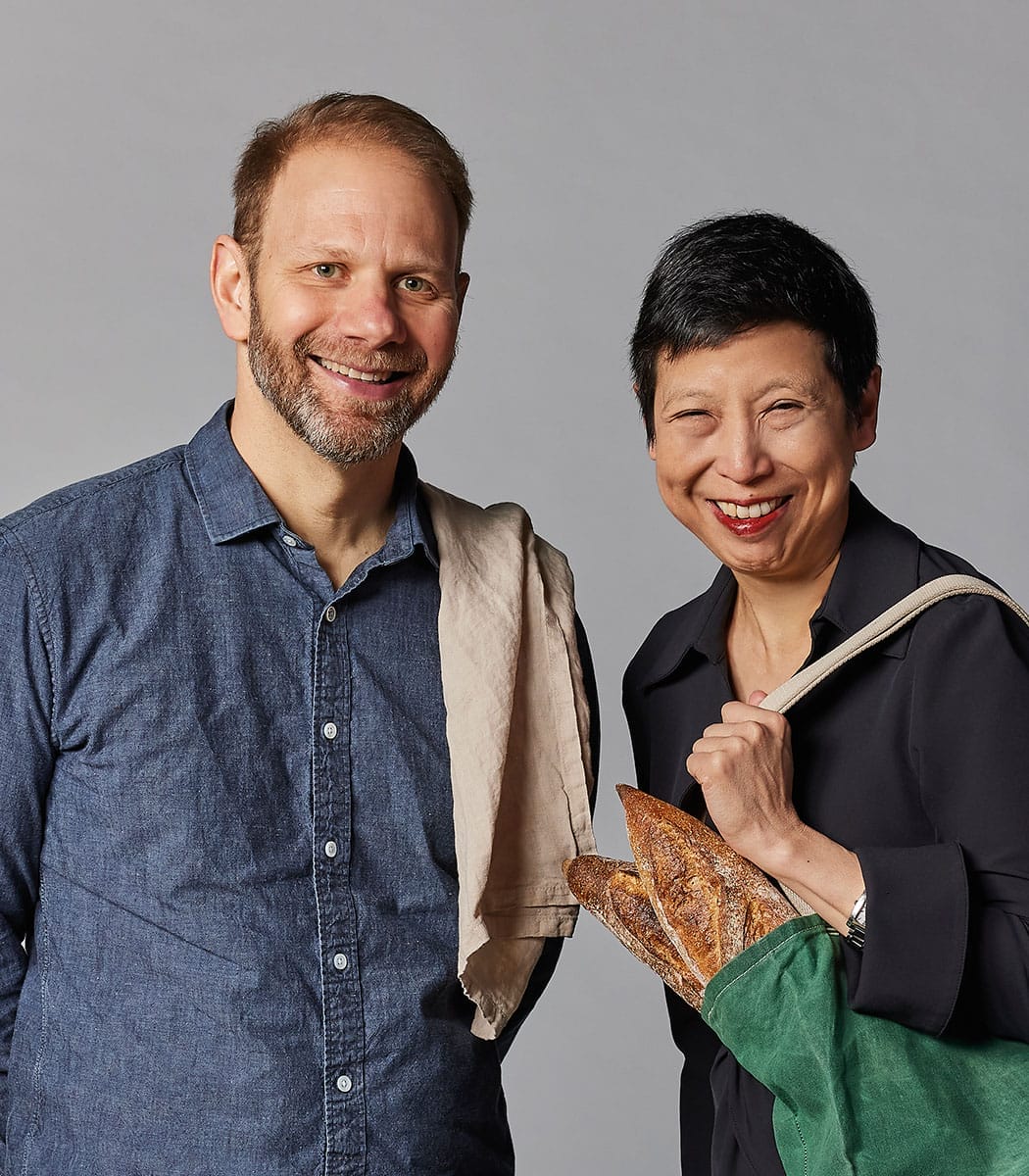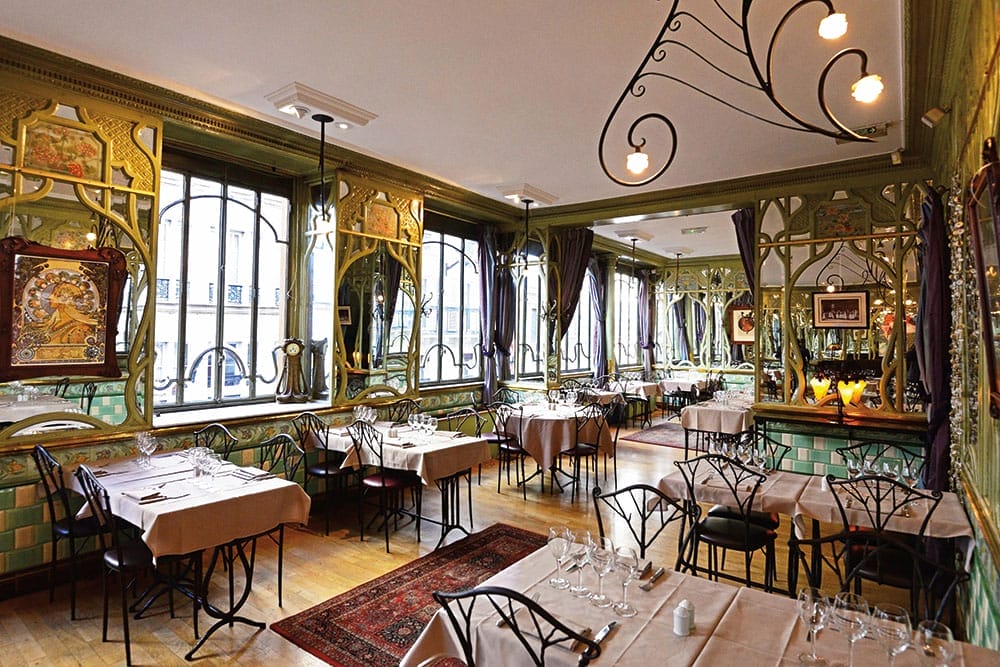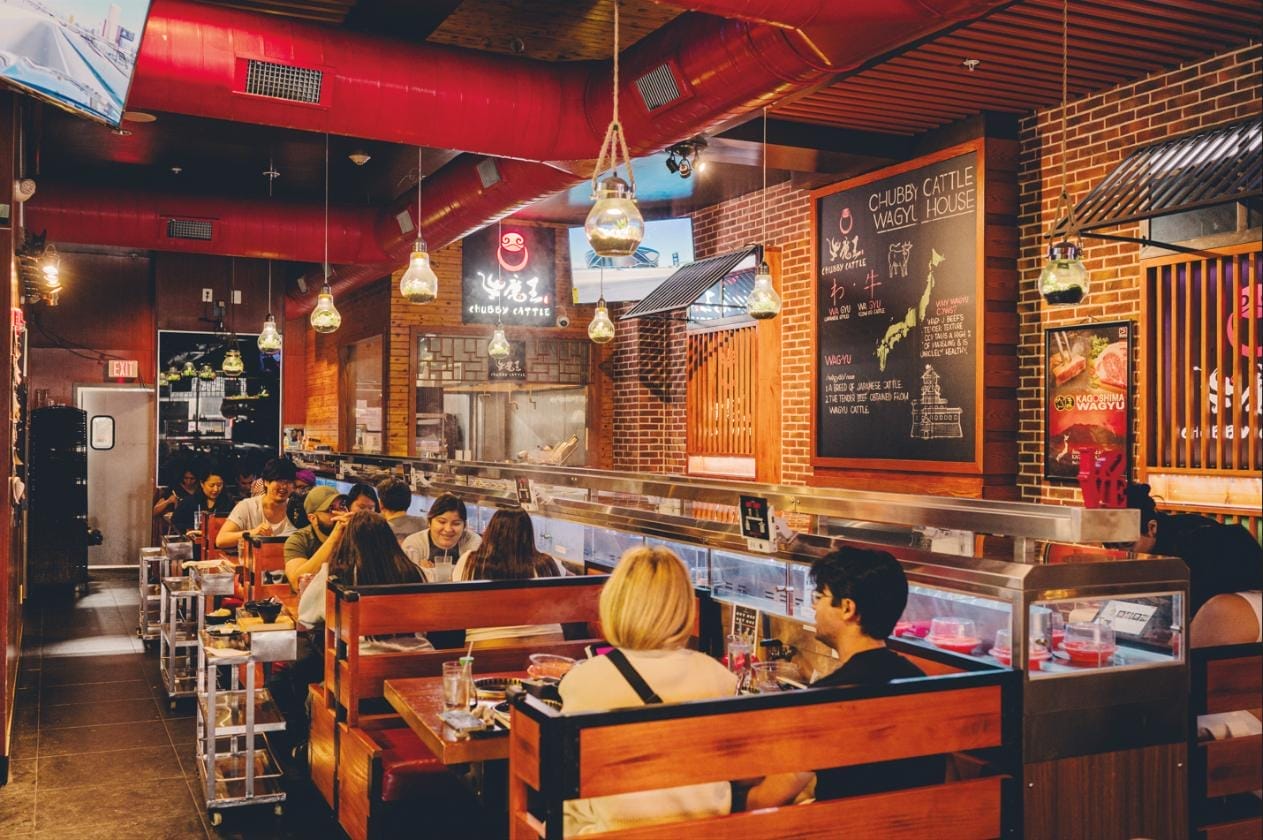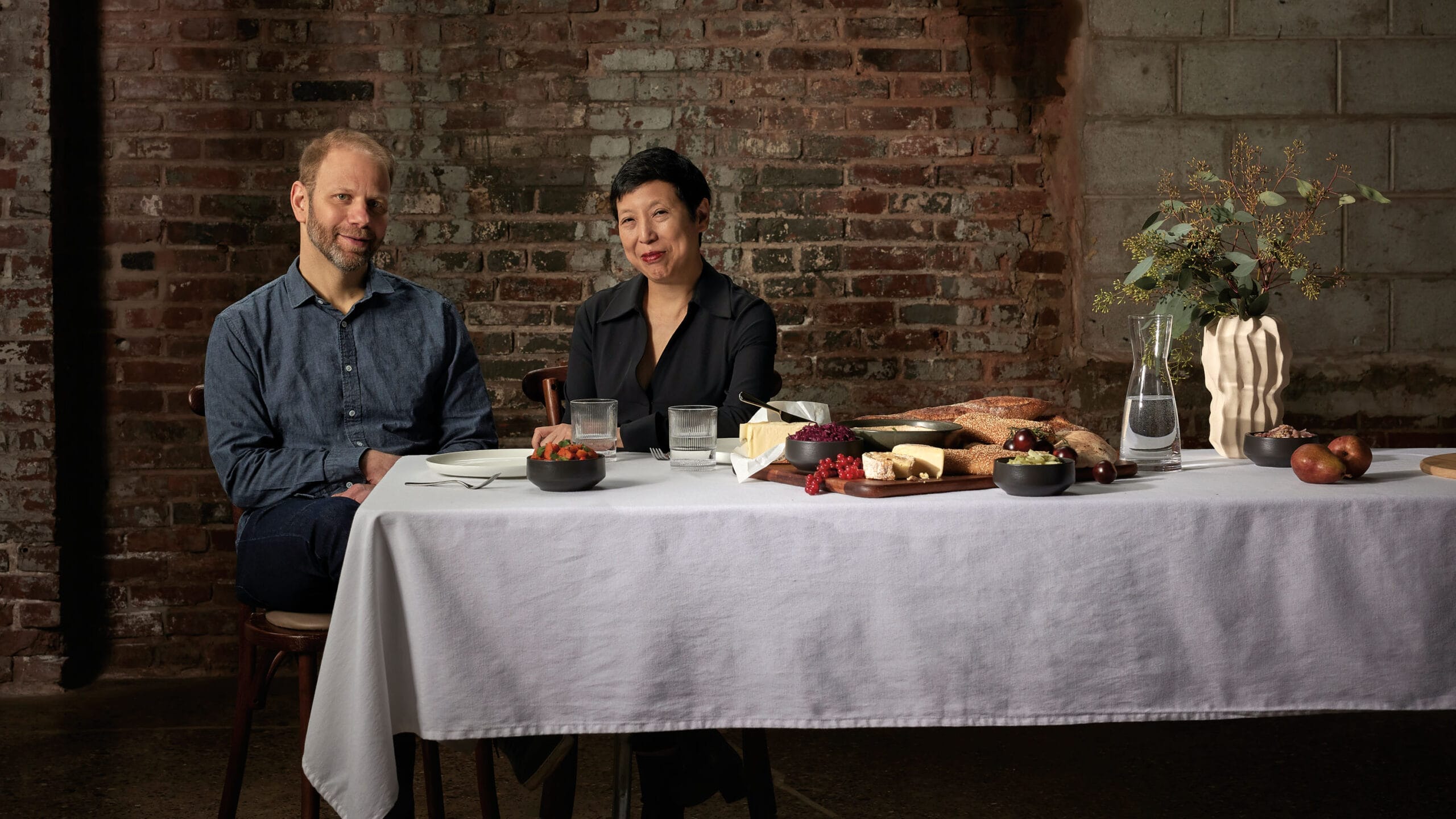Two Generations of Fine Dining
A conversation between Ellen Yin W87 WG93 and Steve Cook W95, titans who have defined the ever-growing Philadelphia food scene for decades
Ellen Yin and Steve Cook credit some of the success of their renowned Philadelphia restaurant groups to auspicious circumstances. “We were opportunists at the right time,” says Yin, who just last year was named “Outstanding Restaurateur” by the James Beard Foundation for her High Street Hospitality Group. “I opened Fork after the early-’90s economic downturn.”
Yin launched her career as a restaurateur with the Old City staple in 1997, alongside longtime business partner Roberto Sella WG93. Today she oversees a portfolio of restaurants in downtown Philadelphia. In addition to Fork, there’s the French-inspired a.kitchen + bar, the modern American restaurant High Street, the High Street Hoagies sandwich shop, and the Wonton Project, a social-mission venture benefiting organizations that combat anti-Asian discrimination.
Yin’s story is in some ways similar to that of Cook, who opened his second restaurant, the acclaimed Israeli restaurant Zahav, with chef Mike Solomonov in 2008, during the Great Recession. These days, Cook and Solomonov’s James Beard-winning CookNSolo restaurant group includes a range of other Israeli concepts — among them the newly reopened and expanded Dizengoff and the kosher and vegan Goldie. Their Federal Donuts & Chicken also offers its eclectic combination at 10 locations, including one in Las Vegas.

Steve Cook W95 and Ellen Yin W87 WG93 (Photograph by Michael Persico)
In their early days, both Yin and Cook admit, their careers weren’t exactly straightforward. Yin had gotten a taste for dining while working restaurant jobs in high school and college but spent time exploring advertising, fundraising, and consulting before betting on Fork. Reflecting on the uncertainty of their paths, Cook says, “You don’t have to get from here to there. You just have to put one foot in front of the next and keep moving forward bit by bit.” The two Philadelphia culinary icons and friends sat down with Wharton Magazine at Yin’s High Street in February to chat about their journeys, the ways Philadelphia’s dining industry has evolved, and more. A condensed and edited version of the conversation follows.
Wharton Magazine: How would you describe the dining scene in the city when you got started versus how you see it today?
Ellen Yin: The dining scene in Philadelphia since 1997 parallels the national interest in restaurants and dining out. Philadelphia had a restaurant renaissance starting in the late ’70s, right after the recession. We were at the right place at the right time. All the restaurants were either high-end or more approachable ethnic-style restaurants, and there wasn’t much in between. In line with the growth of the city, restaurants have been economic boosters for the different neighborhoods: They put their stake somewhere, and then neighborhoods fill out around them. Dining’s really been part of the economic growth of downtown Philadelphia for many years.
Steve Cook: I agree. I came to Penn in the early ’90s and at that point was not as interested in food, but I saw what was going on. [Mayor] Ed Rendell was in office, and he did all these things to foster Philadelphia’s dining scene. I filed that away and lived in New York for six years after graduation. That restaurant scene was obviously so developed and competitive. In Philly, it seemed like there was a lot of opportunity, which is one of the reasons I moved back. Even in the early 2000s, when I started, it felt like there was a lot of open space. I think that’s a little less true now.
WM: What advice would you give to restaurateurs trying to enter the business now?
SC: There’s a bunch of crosswinds going in the opposite direction. The traditional restaurant background we came from is extremely demanding and didn’t allow a lot of time for personal lives. Since the pandemic, a lot of people getting into the industry want to write their own playbook. Some will succeed, and some won’t. It is more competitive than when we started, but I think people who have a unique perspective and work hard will succeed.
EY: Part of it has to do with context. We were coming up during the rise of celebrity chefdom. When I started, Emeril wasn’t a household name yet. The evolution of chefs as a creative force in the restaurant came to a peak at the pandemic, which broke everything. Anytime something’s broken, that creates opportunity: You see people doing supper clubs and pop-ups, and people who don’t have a restaurant but still manage to create a restaurant experience. If you have the drive to write your own ticket, you’re going to. That’s what an entrepreneur does. People who are newly opening restaurants at some point are going to want to grow, because that’s what happens with entrepreneurs. When you started, did you think you wanted multiple restaurants?
SC: Before Marigold [Cook’s first restaurant], I worked in investment banking in New York for six years. Back then, I thought all I wanted was a little restaurant, and I would spend the rest of my life in that kitchen. But after, like, two weeks, I knew it was not sustainable. The people who succeed have the drive to grow. It’s sort of innate, but they’re also probably looking at their first project and going, “Everybody seems to love it, but I’m literally not making it. … ”
EY: Working 23 hours a day and making $50,000 a year.
SC: Or less, in the case of Marigold. I think growth is inevitable for those reasons.
WM: What gave you the confidence to step out on your own?
EY: I didn’t love what I was doing. I always had a dream to own a restaurant. I say to everybody that if you’re not happy, you’re the only person who can control making a change. At first, I was scared, but I thought, “What do I have to lose?” At that point in my life, I’d saved enough money to invest in a restaurant, and if I lost it all, I would go back and get another job. I had everything to gain for my personal happiness and career.
SC: When I was in New York, we would host these dinner parties where I would cook. Juxtaposed against finance, it was clear that I should be doing one of those things and not the other. Sometimes you do things to prove to yourself that you can. I ended up going to culinary school and was a line cook for two years. I had a bit of money saved and wanted to try — if it didn’t work out, I was still employable.
WM: Switching gears, you’ve both talked before about how hospitality is one of the most important aspects of your concepts, if not the most important.
EY: When you think about many different businesses, customer service is sometimes more important than the actual product, because we’re all human, and things are constantly changing. The human part is what sets you apart from everybody else. I’ve always had the belief that no matter what you’re doing — whether it’s serving falafel or sandwiches — it’s the people who make you feel comfortable. I started out on the service side of things, so I love serving people. I want to infuse all my teams with that feeling that we’re there to create a great time for our guests.
SC: I agree.
WM: What do you both look for in business partners?
SC: Mike [Solomonov] and I have been working together for many years. Sometimes, you just get lucky. Sometimes, you go into things because you have a good feeling about it, and sometimes it works, and sometimes it doesn’t. Trust is the foundation of any relationship. You have to find or build trust.
EY: My primary business partner and I have been partners for 26 years, and we’ve had other partners. The word “partner” itself has multiple definitions: Your landlord or your chef can be your partner.
SC: Life is about compromise, and it’s important to know yourself and what you’re willing to compromise on. Finding people who share those values makes for good partnership.
WM: What were some of the qualities in your existing partnerships that have reassured you they would work long-term?
SC: Long-term is the key. My partner and I always take a long-term view: We’re willing to invest and take a little less if we think it maximizes our chances for long-term success.
EY: That’s well-put.
WM: What do the next couple of years look like for each of your groups?
SC: During the pandemic, I thought, “That’s it. We’re done.” But we’ve probably expanded more than ever since. We’ve got a couple local projects in the works. At some point, we’ll probably run out of ground in Philly.
EY: We’ve been working since 2020 on bolstering our core team. Our main goal is to continue to solidify our brand, and perhaps we could take some concepts and grow them differently. For example, we want to see whether we can scale High Street Hoagies and if the Wonton Project has potential to become more brick-and-mortar.
WM: I’m hearing from you both how pivotal the pandemic was. What are some lessons learned?
SC: We had the ability to see what our values were, including quality of life for our employees. In our profession, you get to make people happy. We would serve ourselves well to be able to create a model that’s sustainable for our employees.
EY: And that’s a moving target, because what young people want today versus what young people wanted when I was coming up are completely different. But trying to create something that can work for everybody, meaning benefits such as paid time off and paternity leave — those things can only happen if the business model is successful. Trying to figure out what that model could look like — I think we’re both passionate about that and taking risks.
Taste of Paris
For Luc Morand WG94, a career crossroads led to a second act as the proprietor of a historical monument in one of the world’s food capitals.

Luc Morand WG94
Restaurant ownership was supposed to be a short stint for Luc Morand. “This was my mid-life crisis when I was 40 years old,” says the owner of Bouillon Racine, situated in the heart of Paris. Established in 1906, the restaurant was featured in the New York Times’s “36 Hours” travel column last year for its traditional Parisian fare and the original Art Nouveau decor that earned it status as a historical monument in 1995.
After some time working in consulting and in the packaging industry, Morand had had enough. His father, himself a restaurant owner, had gotten word that Bouillon Racine had fallen on hard times and was in need of new owners. “It started as a family business,” says Morand. “I was going to take a year off and start working on new ventures. But then I realized I really love food and service — and I really love where I am.”
Now, after more than two decades in the industry, Morand admits that the purchase of Bouillon Racine in 2002 flew in the face of what he learned in business school. “It’s not scalable,” he says. “It’s a historical monument; you cannot reproduce it.”

Bouillon Racine
But buying the restaurant was just the start of a string of purchases for Morand. Today, he owns four restaurants in Paris’s Sixth Arrondissement, all a few minutes’ walk from each other. In addition to Bouillon Racine, there’s Polidor, founded in 1845 and known for the famous writers who have frequented it, including Ernest Hemingway. (That history landed the restaurant an appearance in Woody Allen’s 2011 film Midnight in Paris.) Then there’s the Italian restaurant Fuxia and the upscale French location Ekinox, both of which Morand bought this year after selling two other locations in 2019 and 2021. “What I really like,” says Morand, “is working on new projects: making business plans, negotiating, and — when I buy — planning a new kitchen, menus, and decoration.”
Among his other recent projects was the establishment in 2018 of Le Bar du Bouillon, a wine and tapas bar just next door to Bouillon Racine. “I wanted to have a place that would complement the restaurant,” says Morand. “We worked with an architect to try to replicate the same atmosphere.”
Like Yin and Cook, Morand has been particularly focused on recent changes in the workforce. “Especially after COVID, it has become really difficult to hire and keep people,” he says. Responding to those changes, he reorganized hours to reduce lengthy shifts and has raised salaries by about 30 percent. Although those changes are a more challenging aspect of the job these days, they speak squarely to what Morand enjoys most about his work. “There are always new problems to solve,” he says. “You have to be really flexible.”
When Food Is Family
A daughter of the “mother of fusion cuisine,” Jacqueline An WG07 is cementing a multigenerational legacy through her work in California — and charting a course of her own.

Jacqueline An WG07
Jacqueline An’s earliest memory offers lessons on the importance of both hard work and spending time with family. “It was going to the restaurant and peeling carrots and onions, rolling spring rolls, and making dumplings,” says An, speaking of the eatery her grandmother, Diana An, opened more than 50 years ago in San Francisco. That restaurant — a small deli when Diana purchased it in 1971 — has since become Thanh Long, the Vietnamese restaurant where the culinary story of Jacqueline’s family began.
Now, their House of An oversees a variety of California restaurants, including Crustacean in San Francisco and Beverly Hills, Tiato in Santa Monica, and Anqi in Orange County. (A new Crustacean is also slated to open in San Francisco this year.) The Ans’ success, in large part, was propelled by Diana’s daughter-in-law and Jacqueline’s mother, Helene An, who joined Diana in the United States after she and her family fled Vietnam during the fall of Saigon. It was at the deli that Helene began experimenting with recipes incorporating flavors from different countries, including garlic- and herb-flavored chow mein noodles.

Crustacean (Beverly Hills)
That creativity and the following she gained have earned her renown from the Smithsonian and the California and Asian halls of fame as the “mother of fusion cuisine” and distinction for mainstreaming Vietnamese cuisine in the U.S.
These days, Helene doesn’t run the business alone; her five daughters — and even one granddaughter — are all involved in the House of An. For Jacqueline, that means focusing on strategy and development. “With all the restaurants, the whole family jumps in to help,” she says. “We’re all well-versed in making garlic noodles and roasted crab, our signature dishes. But my focus is researching food trends and consulting on the menus.”
Jacqueline’s work for the business also includes special projects such as An: To Eat, the cookbook she and Helene published together in 2016. (Coincidentally but highly aptly, the family’s last name means “to eat” in Vietnamese.) For Jacqueline, the cookbook was a way to memorialize her family’s recipes and stories passed down: “I wanted something for my kids to look back at later that captured not only the recipes, but the legacy that my grandmother and mother created for us.”
Today, Jacqueline is also passing on her knowledge and love for Vietnamese cooking through a project of her own: a line of medicinal bone broths called Súp. “Growing up, we would have bone broth that was delicious, healing, and made you feel good after drinking it,” she says. Launching the brand has been a full-circle moment for her with her own children, she adds: “As a kid, it was really important for me to see my parents working hard and making things happen.”
Feast for All Senses
Following the success of his restaurant group in Las Vegas, David Zhao W20 is bringing high-end hot pot to diners across the country.

David Zhao W20
Refrigerated food conveyor belts, immersive projections, and robot servers: A tech-infused take on hot pot has catapulted David Zhao’s Chubby Group into the limelight. Zhao and co-founder Habin Yang — Forbes 30 Under 30 honorees — started their dining group in 2015 with their first Chubby Cattle restaurant in Las Vegas’s Chinatown, before Zhao enrolled at Wharton. The duo met while Zhao was doing marketing consulting for restaurants, to come up with his tuition for school. “I saw a huge gap in Asian cuisines and the U.S. demographic,” says Zhao, 29. “The restaurants I was working with were mostly serving Asian clients, versus what we want, which is for this food to be experienced by everyone in the States.”
Zhao has carried that mission into his entrepreneurial work with Yang. Together, they’re on track to expand to 40 of their own locations this year from 17 at the start of the year. In addition to hot-pot spots from coast to coast, their restaurant group now has a range of brands serving BBQ, Japanese curry, and other Asian cuisines.

Chubby Cattle (Philadelphia)
The 2020 opening of X Pot — a flagship hot-pot location in Las Vegas’s Venetian Resort — was a milestone moment for the group. “That was the biggest project we’ve ever done,” Zhao says of the roughly 11,000-square-foot, $10 million space, which the pair opened after the popularity of their first Chubby Cattle location put their concept on the Venetian’s radar. X Pot alone — tabletop light shows, 360-degree projections, and other technology add to the experience — generates $18 million a year now, Zhao notes.
From there, things took off. “We’ve gone from being a tenant to being a partner of various properties,” Zhao says. “We see a lot more friendly offers now.” Another evolution of the business: The pair have established their own supply chains, including a cattle ranch on the West Coast and a caviar brand called Chubby Caviar. “This year, we’re going to scale up our seafood supply chain as well,” says Zhao.
That’s all part of a larger vision to establish a vertically and horizontally integrated business model for Chubby Group, from how ingredients are sourced to how customers experience dining across all its concepts.
As part of that vision — and in line with its tech-forward focus — Chubby Group also offers memberships in the form of NFTs that can be used at all locations for perks such as free food and priority reservations. “The users own the membership like how you’d own a Rolex watch,” says Zhao. “It’s a lifetime membership that you can sell or transfer down the line.” As for the process of building their concept from the ground up, Zhao isn’t shy about the twists and turns of entrepreneurship. “It’s had a lot of ups and downs,” he says. “You dream where you will be in three or six months, and that dream might completely change, and I think I’m a living example of that. Living on construction sites and flying back and forth during college — those tough times that I thought I hated were high points of the journey when I look back.”
Published as “A Culinary Calling” in the Spring/Summer 2024 issue of Wharton Magazine.

























